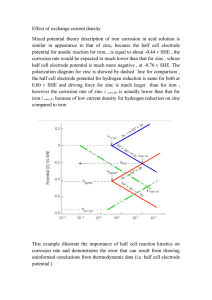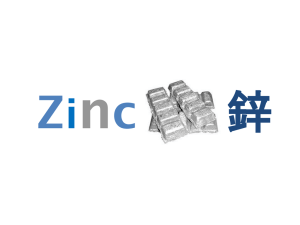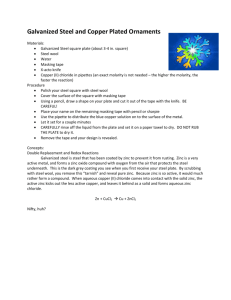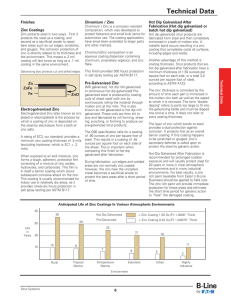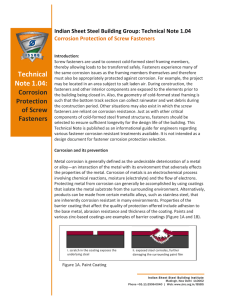MATERIALS
advertisement
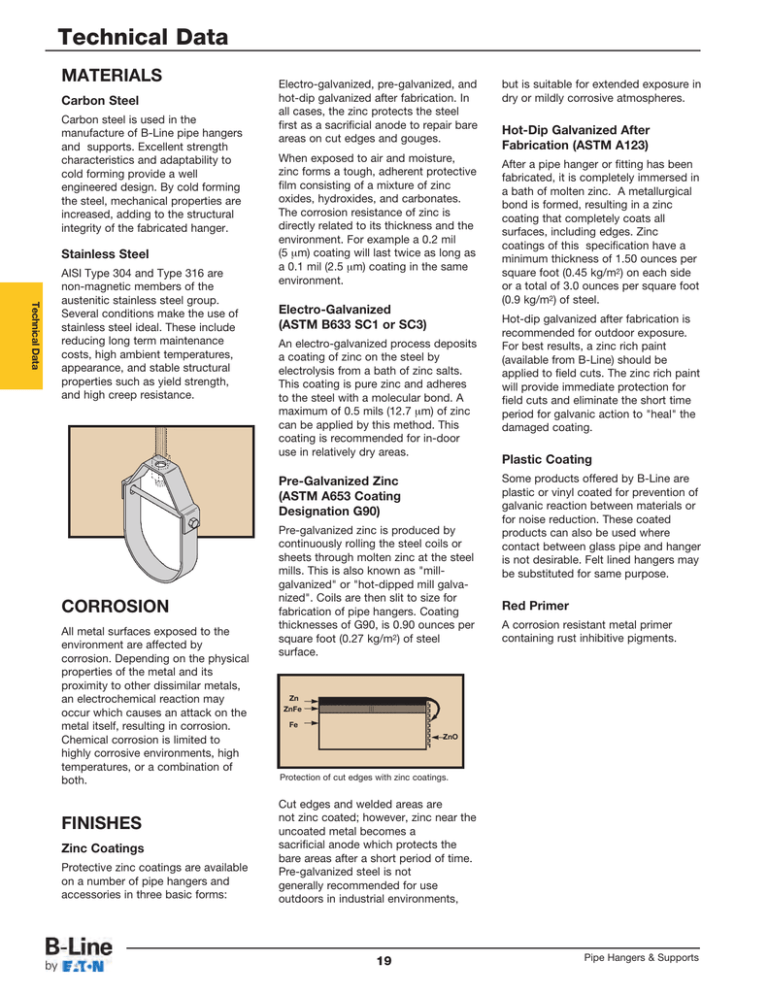
Technical Data MATERIALS Carbon Steel Carbon steel is used in the manufacture of B-Line pipe hangers and supports. Excellent strength characteristics and adaptability to cold forming provide a well engineered design. By cold forming the steel, mechanical properties are increased, adding to the structural integrity of the fabricated hanger. Stainless Steel Technical Data AISI Type 304 and Type 316 are non-magnetic members of the austenitic stainless steel group. Several conditions make the use of stainless steel ideal. These include reducing long term maintenance costs, high ambient temperatures, appearance, and stable structural properties such as yield strength, and high creep resistance. Electro-galvanized, pre-galvanized, and hot-dip galvanized after fabrication. In all cases, the zinc protects the steel first as a sacrificial anode to repair bare areas on cut edges and gouges. When exposed to air and moisture, zinc forms a tough, adherent protective film consisting of a mixture of zinc oxides, hydroxides, and carbonates. The corrosion resistance of zinc is directly related to its thickness and the environment. For example a 0.2 mil (5 μm) coating will last twice as long as a 0.1 mil (2.5 μm) coating in the same environment. Electro-Galvanized (ASTM B633 SC1 or SC3) An electro-galvanized process deposits a coating of zinc on the steel by electrolysis from a bath of zinc salts. This coating is pure zinc and adheres to the steel with a molecular bond. A maximum of 0.5 mils (12.7 μm) of zinc can be applied by this method. This coating is recommended for in-door use in relatively dry areas. Pre-Galvanized Zinc (ASTM A653 Coating Designation G90) CORROSION All metal surfaces exposed to the environment are affected by corrosion. Depending on the physical properties of the metal and its proximity to other dissimilar metals, an electrochemical reaction may occur which causes an attack on the metal itself, resulting in corrosion. Chemical corrosion is limited to highly corrosive environments, high temperatures, or a combination of both. FINISHES Zinc Coatings Protective zinc coatings are available on a number of pipe hangers and accessories in three basic forms: Pre-galvanized zinc is produced by continuously rolling the steel coils or sheets through molten zinc at the steel mills. This is also known as "millgalvanized" or "hot-dipped mill galvanized". Coils are then slit to size for fabrication of pipe hangers. Coating thicknesses of G90, is 0.90 ounces per square foot (0.27 kg/m2) of steel surface. but is suitable for extended exposure in dry or mildly corrosive atmospheres. Hot-Dip Galvanized After Fabrication (ASTM A123) After a pipe hanger or fitting has been fabricated, it is completely immersed in a bath of molten zinc. A metallurgical bond is formed, resulting in a zinc coating that completely coats all surfaces, including edges. Zinc coatings of this specification have a minimum thickness of 1.50 ounces per square foot (0.45 kg/m2) on each side or a total of 3.0 ounces per square foot (0.9 kg/m2) of steel. Hot-dip galvanized after fabrication is recommended for outdoor exposure. For best results, a zinc rich paint (available from B-Line) should be applied to field cuts. The zinc rich paint will provide immediate protection for field cuts and eliminate the short time period for galvanic action to "heal" the damaged coating. Plastic Coating Some products offered by B-Line are plastic or vinyl coated for prevention of galvanic reaction between materials or for noise reduction. These coated products can also be used where contact between glass pipe and hanger is not desirable. Felt lined hangers may be substituted for same purpose. Red Primer A corrosion resistant metal primer containing rust inhibitive pigments. Zn ZnFe Fe ZnO Protection of cut edges with zinc coatings. Cut edges and welded areas are not zinc coated; however, zinc near the uncoated metal becomes a sacrificial anode which protects the bare areas after a short period of time. Pre-galvanized steel is not generally recommended for use outdoors in industrial environments, 19 Pipe Hangers & Supports Technical Data DURA-COPPER and DURA-GREEN are water borne epoxy coatings applied to B-Line products by a precisely controlled cathodic electrodeposition process. This process is accomplished using a conveyor to transport parts through several cleaning, phosphatizing and application stages prior to being baked (See diagram below). This custom designed paint system is used for painting all copper painted hanger parts and all green channel, slotted angle and fittings. Samples are selected on a routine basis for Salt Spray (fog) testing to verify the quality of the finish. These tests are performed in accordance with ASTM B117-73 and evaluated and rated according to ASTM D1654-79 (Tables 1 & 2). The DURA-COPPER and DURA-GREEN Epoxy coatings have been tested and listed by Underwriters Laboratories in accordance with "Standard for Pipe Hanger Equipment for Fire Protection Service, UL 203" and meet or exceed all requirements of Federal Specification TT-C-490B Paragraph 3. Quality Assurance B-Line’s Quality Assurance Program has been developed and implemented for compliance to various industry standards and specifications. DURA-COPPER™ & DURA-GREEN™ EPOXY COATING PROCESS TANK 1 TANK 2 TANK 3 TANK 4 TANK 5 TANK 6 TANK 7 TANK 8 BAKE OVEN Parts are thoroughly cleaned and phosphatized. Rinse is applied to remove insoluble salts and unreacted phosphates. Phosphatized sealer is applied to insure corrosion resistance and paint adhesion. The material moves through clear water rinse to remove excess phosphates. Deionized rinse prepares the metal for the cathodic electro-coating. The electrocoating tank applies a uniform coat of epoxy paint to the entire surface. The first post rinse removes any unelectrically attracted solids. The final rinse insures a smooth, nonblemish finish. The curing process takes 20 minutes at a baking temperature of 375°F (199°C). SALT SPRAY TEST RESULTS DURA-COPPER out performs Copper Plating 4 to 1 DURA-COPPER Epoxy Copper Plating Elapsed Time (1) All salt spray (fog) tests conducted in accordance with ASTM B117-73 and evaluated and rated according to ASTM D1654-79 Tables 1 & 2. Tests were performed and certified by an independent testing laboratory. General Information Torque The torque values in this catalog are to be used as a guide only. The relationship between the applied torque or torque wrench reading and the actual tension created in the bolt may be substantially different. Important factors affecting torque-tension relationships include friction under the bolt head or nut, hole tolerances, and torque wrench tolerances. Accuracy of many commercial torque wrenches may vary as much as plus or minus 25%. Charts and Tables Charts and tables in this section are compiled from information published by nationally recognized organizations and are intended for use as a guide only. B-Line recommends that users of this information determine the validity of such information as applied to their own applications. Eaton’s B-Line reserves the right to make specification changes without notice. Pipe Hangers & Supports 20 Technical Data DURA-COPPER™ and DURA-GREEN™ Epoxy Coatings
